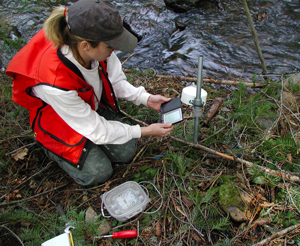xxx,xxx,xxx,xxx
METRIC TONS OF CO2
EQUIVALENT TO
SCRUBBING FROM THE AIR THE ANNUAL
CO2 EMISSIONS FROM xxx.xxx,xxx,xxx VEHICLES
Watersheds / Water Quality

Clean water starts with healthy watersheds. A watershed is a drainage area whose boundary is formed by ridge tops.
Before any harvesting occurs on Sierra Pacific Industries lands, professional foresters visit the watershed and classify all lakes, rivers, creeks, springs, and ditches using a standardized classification system. A buffer zone of vegetation is left around each lake and watercourse. These zones act as sediment-filtering strips, shade canopy, sources of woody debris, and stream bank and channel stabilizers. Tree removal is restricted in these zones and heavy equipment is limited or excluded.
Fish and other aquatic life also rely on healthy watersheds. In addition to maintaining buffer zones, foresters reduce the potential for sediment reaching streams by properly locating roads and stream crossings. Reducing erosion contributes to the maintenance of healthy watersheds. Although erosion is a natural process that can't be totally eliminated, SPI's foresters take precautions to keep management-related erosion to a minimum. Proper planning, careful installation of roadbeds, and preventative maintenance are key factors.
One of the best ways to determine if watersheds are healthy is to perform long-term monitoring of streams and lakes. This science-based approach studies changes in water quality over time and examines the impact forest management has on these ecosystems. The Research and Monitoring Department at SPI collects biotic and abiotic samples from watercourses to determine the effect of harvesting operations. In addition to long-term monitoring, peer reviewed scientific experiments are performed to measure the effects of forest management on watercourse zones and riparian buffers. Sierra Pacific researchers and biologists collect census data for fish in several key streams. We also sample aquatic insects in numerous streams for use as water quality indicators. To date, monitoring has not indicated an adverse effect on water quality as a result of Sierra Pacific's management activities.
Minimizing Soil Erosion
Forested lands are important links in California's water supply network because their large expanses of soil and leaf litter are relatively undisturbed, allowing them to serve as natural water filters. Approximately 75 percent of California's water comes from forested watersheds. That's why Sierra Pacific takes its responsibility to protect water quality so seriously.
One of Sierra Pacific's primary goals is to keep soil where it is needed to grow trees – and away from spots where it is detrimental to water quality or fish habitat. Although erosion is a natural process that can't be totally eliminated, SPI's foresters take precautions to keep management-related erosion to a minimum. Proper planning, careful installation of roadbeds, and preventative maintenance are key factors. SPI employs registered professional foresters to determine the ability of the soil to grow trees and estimate the soil's susceptibility to erosion.
Our Road System
Poorly designed roads without adequate drainage can affect water quality and wildlife. That is why SPI makes its privately maintained road system a top priority. Roads and their accompanying drainage structures are installed only by experienced road builders. Roads are maintained on a regular basis and regularly inspected by SPI foresters. If at all possible, roads are rerouted to avoid sensitive areas.

